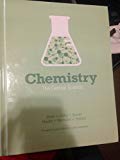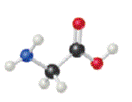
Chemistry the Central Science 13th Edition Custom for Lamar University
13th Edition
ISBN: 9781269962667
Author: Theodore L. Brown, H. Eugene LeMay Jr., Bruce E. Bursten, Batherine J. Murphy, Patrick M. Woodward, Matthew W. Stoltzfus
Publisher: Pearson Learning Center
expand_more
expand_more
format_list_bulleted
Concept explainers
Textbook Question
Chapter 12.5, Problem 12.2.2PE
Glycine, an amino acid used by organisms to make proteins, is represented by the following
molecuar model
a. Write its molecular formula.
b Determine its molar mass
c. Calculate how many moles of glycine are in a 100.0-g sample of glycine.
d Calculate the percent nitrogen by mass in glycine [Sections 3.3 and 3.5]

Expert Solution & Answer
Want to see the full answer?
Check out a sample textbook solution
Students have asked these similar questions
Solve this
く
Predicting the pr
Predict the major products of the following organic reaction:
Δ
Some important notes:
• Draw the major product, or products, of the reaction in the drawing area below.
• If there aren't any products, because no reaction will take place, check the box below the drawing area instead.
• Be sure to use wedge and dash bonds when necessary, for example to distinguish between major products that are
enantiomers.
?
Click and drag to start drawing a structure.
propose synthesis
Chapter 12 Solutions
Chemistry the Central Science 13th Edition Custom for Lamar University
Ch. 12.3 - The following diagram shows the combination...Ch. 12.3 -
3.3 The following diagram represents the...Ch. 12.5 -
3.4 The following diagram represents the...Ch. 12.5 - Glycine, an amino acid used by organisms to make...Ch. 12.7 - The following diagram represents a...Ch. 12.7 -
3.7 Nitrogen (N2) and hydrogen (H2) react to form...Ch. 12.7 -
3.8 Nitrogen monoxide and oxygen react to form...Ch. 12.7 - Write "true" or "false" for each statement. a. We...Ch. 12 - Determine the empirical and molecular formulas of...Ch. 12 - a. Combustion analysis of toluene, a common...
Ch. 12 -
3.67 Automotive air bags infilate when sodium...Ch. 12 - Prob. 3ECh. 12 - Prob. 4ECh. 12 -
12.5 Which of these molecular fragments would...Ch. 12 - Prob. 6ECh. 12 - Prob. 7ECh. 12 - Prob. 8ECh. 12 - Prob. 9ECh. 12 - Prob. 10ECh. 12 - Prob. 11ECh. 12 - Prob. 12ECh. 12 - 12.13 Indicate the type of solid (molecular,...Ch. 12 - Prob. 14ECh. 12 -
12.15 A white substance melts with some...Ch. 12 -
12.16 You are given a white substance that...Ch. 12 - Prob. 17ECh. 12 - Prob. 18ECh. 12 - Prob. 19ECh. 12 - Prob. 20ECh. 12 - Prob. 21ECh. 12 - Prob. 22ECh. 12 - Prob. 23ECh. 12 - Prob. 24ECh. 12 - Prob. 25ECh. 12 - Prob. 26ECh. 12 - Prob. 27ECh. 12 - Prob. 28ECh. 12 - Prob. 29ECh. 12 - Prob. 30ECh. 12 - Prob. 31ECh. 12 - Prob. 32ECh. 12 - Prob. 33ECh. 12 - Prob. 34ECh. 12 - Prob. 35ECh. 12 - Prob. 36ECh. 12 - Prob. 37ECh. 12 - Prob. 38ECh. 12 - Prob. 39ECh. 12 - Prob. 40ECh. 12 - Prob. 41ECh. 12 - Prob. 42ECh. 12 - Prob. 43ECh. 12 - Prob. 44ECh. 12 - Prob. 45ECh. 12 - Prob. 46ECh. 12 - Prob. 47ECh. 12 - Prob. 48ECh. 12 -
12.49 Which would you expect to be the more...Ch. 12 - Prob. 50ECh. 12 - Prob. 51ECh. 12 - Prob. 52ECh. 12 - Prob. 53ECh. 12 - Prob. 54ECh. 12 - Prob. 55ECh. 12 - Clausthalite is a mineral composed of lead...Ch. 12 - Prob. 57ECh. 12 - Prob. 58ECh. 12 - Prob. 59ECh. 12 - Prob. 60ECh. 12 - Prob. 61ECh. 12 - Prob. 62ECh. 12 - Prob. 63ECh. 12 - Prob. 64ECh. 12 - Prob. 65ECh. 12 - Prob. 66ECh. 12 - Prob. 67ECh. 12 - Prob. 68ECh. 12 - Prob. 69ECh. 12 - Prob. 70ECh. 12 - Prob. 71ECh. 12 - Prob. 72ECh. 12 - Prob. 73ECh. 12 - Prob. 74ECh. 12 - Prob. 75ECh. 12 - Prob. 76ECh. 12 - Prob. 77ECh. 12 - Prob. 78ECh. 12 - Prob. 79ECh. 12 - Prob. 80ECh. 12 - Prob. 81ECh. 12 - Prob. 82ECh. 12 - Prob. 83ECh. 12 - Prob. 84ECh. 12 - Prob. 85ECh. 12 - Prob. 86ECh. 12 - Prob. 87ECh. 12 - Prob. 88ECh. 12 - Prob. 89ECh. 12 - Prob. 90ECh. 12 - Prob. 91ECh. 12 - Prob. 92ECh. 12 - Prob. 93ECh. 12 - Prob. 94ECh. 12 - Prob. 95ECh. 12 - Prob. 96ECh. 12 - Prob. 97ECh. 12 - Prob. 98ECh. 12 - Prob. 99AECh. 12 - Prob. 100AECh. 12 - Prob. 101AECh. 12 - Prob. 102AECh. 12 - Prob. 103AECh. 12 - What type of lattice—primitive cubic body-centered...Ch. 12 - Prob. 105AECh. 12 - Prob. 106AECh. 12 - Prob. 107AECh. 12 - Prob. 108AECh. 12 - Prob. 109AECh. 12 - Prob. 110AECh. 12 - Prob. 111AECh. 12 - Prob. 112AECh. 12 - Prob. 113AECh. 12 - 12.114 Germanium has the same structure as...Ch. 12 - Prob. 115AECh. 12 - Prob. 116AECh. 12 - The karat scale used to describe gold alloys is...Ch. 12 - Prob. 118IECh. 12 - Prob. 119IECh. 12 - Prob. 120IECh. 12 - Prob. 121IECh. 12 - Prob. 122IECh. 12 - Prob. 123IECh. 12 - Prob. 124IECh. 12 - Prob. 125IE
Knowledge Booster
Learn more about
Need a deep-dive on the concept behind this application? Look no further. Learn more about this topic, chemistry and related others by exploring similar questions and additional content below.Similar questions
- Explanation O Conjugated Pi Systems Deducing the reactants of a Diels-Alder reaction Can the molecule on the right-hand side of this organic reaction be made in good yield from no more than two reactants, in one step, by moderately heating the reactants? ? Δ If your answer is yes, then draw the reactant or reactants in the drawing area below. You can draw the reactants in any arrangement you like. • If your answer is no, check the box under the drawing area instead. Click and drag to start drawing a structure. Xarrow_forwardDiels Alder Cycloaddition: Focus on regiochemistry (problems E-F) –> match + of thedienophile and - of the diene while also considering stereochemistry (endo).arrow_forwardHELP! URGENT! PLEASE RESOND ASAP!arrow_forward
- Question 4 Determine the rate order and rate constant for sucrose hydrolysis. Time (hours) [C6H12O6] 0 0.501 0.500 0.451 1.00 0.404 1.50 0.363 3.00 0.267 First-order, k = 0.210 hour 1 First-order, k = 0.0912 hour 1 O Second-order, k = 0.590 M1 hour 1 O Zero-order, k = 0.0770 M/hour O Zero-order, k = 0.4896 M/hour O Second-order, k = 1.93 M-1-hour 1 10 ptsarrow_forwardDetermine the rate order and rate constant for sucrose hydrolysis. Time (hours) [C6H12O6] 0 0.501 0.500 0.451 1.00 0.404 1.50 0.363 3.00 0.267arrow_forwardDraw the products of the reaction shown below. Use wedge and dash bonds to indicate stereochemistry. Ignore inorganic byproducts. OSO4 (cat) (CH3)3COOH Select to Draw ઘarrow_forward
- Calculate the reaction rate for selenious acid, H2SeO3, if 0.1150 M I-1 decreases to 0.0770 M in 12.0 minutes. H2SeO3(aq) + 6I-1(aq) + 4H+1(aq) ⟶ Se(s) + 2I3-1(aq) + 3H2O(l)arrow_forwardProblem 5-31 Which of the following objects are chiral? (a) A basketball (d) A golf club (b) A fork (c) A wine glass (e) A spiral staircase (f) A snowflake Problem 5-32 Which of the following compounds are chiral? Draw them, and label the chirality centers. (a) 2,4-Dimethylheptane (b) 5-Ethyl-3,3-dimethylheptane (c) cis-1,4-Dichlorocyclohexane Problem 5-33 Draw chiral molecules that meet the following descriptions: (a) A chloroalkane, C5H11Cl (c) An alkene, C6H12 (b) An alcohol, C6H140 (d) An alkane, C8H18 Problem 5-36 Erythronolide B is the biological precursor of erythromycin, a broad-spectrum antibiotic. How H3C CH3 many chirality centers does erythronolide B have? OH Identify them. H3C -CH3 OH Erythronolide B H3C. H3C. OH OH CH3arrow_forwardPLEASE HELP! URGENT! PLEASE RESPOND!arrow_forward
- 2. Propose a mechanism for this reaction. ہلی سے ملی N H (excess)arrow_forwardSteps and explanationn please.arrow_forwardProblem 5-48 Assign R or S configurations to the chirality centers in ascorbic acid (vitamin C). OH H OH HO CH2OH Ascorbic acid O H Problem 5-49 Assign R or S stereochemistry to the chirality centers in the following Newman projections: H Cl H CH3 H3C. OH H3C (a) H H H3C (b) CH3 H Problem 5-52 Draw the meso form of each of the following molecules, and indicate the plane of symmetry in each: OH OH (a) CH3CHCH2CH2CHCH3 CH3 H3C. -OH (c) H3C CH3 (b) Problem 5-66 Assign R or S configurations to the chiral centers in cephalexin, trade-named Keflex, the most widely prescribed antibiotic in the United States. H2N H IHH S Cephalexin N. CH3 CO₂Harrow_forward
arrow_back_ios
SEE MORE QUESTIONS
arrow_forward_ios
Recommended textbooks for you
 Chemistry: Principles and ReactionsChemistryISBN:9781305079373Author:William L. Masterton, Cecile N. HurleyPublisher:Cengage Learning
Chemistry: Principles and ReactionsChemistryISBN:9781305079373Author:William L. Masterton, Cecile N. HurleyPublisher:Cengage Learning ChemistryChemistryISBN:9781305957404Author:Steven S. Zumdahl, Susan A. Zumdahl, Donald J. DeCostePublisher:Cengage Learning
ChemistryChemistryISBN:9781305957404Author:Steven S. Zumdahl, Susan A. Zumdahl, Donald J. DeCostePublisher:Cengage Learning Chemistry: The Molecular ScienceChemistryISBN:9781285199047Author:John W. Moore, Conrad L. StanitskiPublisher:Cengage Learning
Chemistry: The Molecular ScienceChemistryISBN:9781285199047Author:John W. Moore, Conrad L. StanitskiPublisher:Cengage Learning Chemistry by OpenStax (2015-05-04)ChemistryISBN:9781938168390Author:Klaus Theopold, Richard H Langley, Paul Flowers, William R. Robinson, Mark BlaserPublisher:OpenStax
Chemistry by OpenStax (2015-05-04)ChemistryISBN:9781938168390Author:Klaus Theopold, Richard H Langley, Paul Flowers, William R. Robinson, Mark BlaserPublisher:OpenStax Introductory Chemistry: A FoundationChemistryISBN:9781337399425Author:Steven S. Zumdahl, Donald J. DeCostePublisher:Cengage Learning
Introductory Chemistry: A FoundationChemistryISBN:9781337399425Author:Steven S. Zumdahl, Donald J. DeCostePublisher:Cengage Learning Chemistry for Engineering StudentsChemistryISBN:9781337398909Author:Lawrence S. Brown, Tom HolmePublisher:Cengage Learning
Chemistry for Engineering StudentsChemistryISBN:9781337398909Author:Lawrence S. Brown, Tom HolmePublisher:Cengage Learning

Chemistry: Principles and Reactions
Chemistry
ISBN:9781305079373
Author:William L. Masterton, Cecile N. Hurley
Publisher:Cengage Learning

Chemistry
Chemistry
ISBN:9781305957404
Author:Steven S. Zumdahl, Susan A. Zumdahl, Donald J. DeCoste
Publisher:Cengage Learning

Chemistry: The Molecular Science
Chemistry
ISBN:9781285199047
Author:John W. Moore, Conrad L. Stanitski
Publisher:Cengage Learning

Chemistry by OpenStax (2015-05-04)
Chemistry
ISBN:9781938168390
Author:Klaus Theopold, Richard H Langley, Paul Flowers, William R. Robinson, Mark Blaser
Publisher:OpenStax

Introductory Chemistry: A Foundation
Chemistry
ISBN:9781337399425
Author:Steven S. Zumdahl, Donald J. DeCoste
Publisher:Cengage Learning

Chemistry for Engineering Students
Chemistry
ISBN:9781337398909
Author:Lawrence S. Brown, Tom Holme
Publisher:Cengage Learning
Step by Step Stoichiometry Practice Problems | How to Pass ChemistryMole Conversions Made Easy: How to Convert Between Grams and Moles; Author: Ketzbook;https://www.youtube.com/watch?v=b2raanVWU6c;License: Standard YouTube License, CC-BY